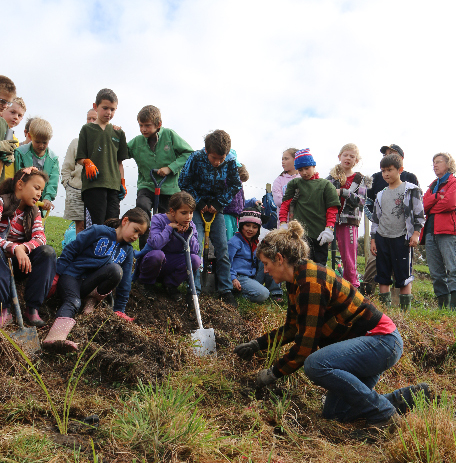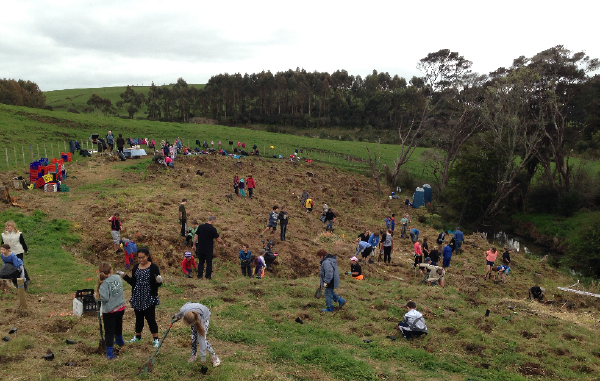Mile-long Mahurangi Farm-Forestry Trail milestone
Developed from report to the 2014 Tane’s Tree Trust annual general meeting

Devotion to Detail: Pupils from Snells Beach School paying devoted attention to Trees for Survival coordinator Eve Clarke demonstrating that most-critical-of-phases-in-the-establishment-of-a-plant: the actual planting. These students were also closely involved in raising the plants from seed at their school, under the Rotary-supported Trees for Survival programme. Photographer Michael Bergin
With the help of 80 school and college pupils, the Mahurangi Farm-Forestry Trail has reached a milestone.
Conceived just two years ago, the mile-long trail is the very happy marriage, and intertwining, of multiple complimentary threads:
- A long-held commitment to farm forestry
- A long-held dream for a network of walking and cycling trials
- The show-casing of Duck Creek, a now beautifully clear-running stream draining a Mahurangi Action Plan priority subcatchment
- The need to slash the cost of establishing indigenous forest
- The need to demonstrate productive means of establishing broader riparian management zones
- The need for easily accessible indigenous farm-forestry demonstration sites.
It was a discussion of the need for readily accessible demonstration sites, aboard a returning field-day bus on the last day of the 2009 national indigenous forestry conference marking Tane’s Tree Trust’s first ten years that led directly to the Mahurangi Farm-Forestry Trail. Attention turned, inexorably, to an obvious candidate: Two years earlier, alongside busy Sandspit Road connecting Warkworth and the Mahurangi peninsula, the first ever plots had been planted to scientifically compare the establishment performance of open-ground and container raised indigenous plants. At one end is The Parsley Pot café, making for a perfect rendezvous point before visiting the demonstration site, but the seed of the trail concept lay dormant until Michael Bergin and Cimino Cole were remeasuring the indigenous open-ground vs. container plants comparison in 2012, when a discussion of a possible second phase of trials was discussed with the property holder, Shelley Trotter.
Aside from an abiding passion in farm forestry, deer farmer Shelley harboured a long-term for vision of a network of walking and cycling trails, including to link the Mahurangi and Matakana wine growing districts. Two years on, and with the help of Auckland Council, Mahurangi Action, the New Zealand Farm Forestry Association, Rodney Local Board, and Tane’s Tree Trust, a mile-long formed trail complete with numerous small and one larger bridge has been formed. In addition to including eucalypt, hickory and walnut farm forestry lots, the trail includes two pairs of regenerating totara permanent sample plots—one plot of each pair will be thinned and pruned; the other being the control.
On 7 August, the first phase of the trail’s first planted indigenous farm forestry was completed. Two teachers and 80 pupils from Mahurangi College and Snells Beach School, eight Rotarians and two Auckland Council coordinators for Trees for Survival planted 1600 indigenous ‘nurse’ trees, shrubs and flaxes on what, until recently was a blackberry-infested and pine stump strewn no-man’s land. Next winter, the area will be interplanted with two-year-old open-ground tōtara, currently being grown at Taupō Native Plant Nursery. With the bulk of the holes having been dug with a powered posthole borer the day before, planting was completed half an hour ahead of schedule, putting considerable pressure on the catering corps. Several hundred sausages later, the younger pupils departed for their bus, while the college pupils walked the balance of trail and back.
Questioned by the senior Trees for Survival coordinator, ahead of the planting, as to why the planting was being undertaken, pupils cited many reasons for riparian planting, but the last word went to a boy, elaborating on another pupil’s assertion that the trees ‘would give us more air’, that plants absorbed carbon dioxide and ‘excreted’ oxygen. Older people, generally, have been slow to comprehend anthropogenic global warming, but these young people are growing up in full awareness of the reality and enormity of it. It is their First World War.

Making Short Work: By having the holes pre-dug by powered posthole borer, in a 900-millimetre grid to ensure that future monitoring yields reliable data, the diminuative planters had completed their work half an hour ahead of the scheduled 1 pm barbecue—leaving keen appetites, hopefully also for future plantings. photographer Michael Bergin
As the last few plants were going in the ground, an exuberant college student exclaimed:
I can’t wait to come back here in 50-years time to see how they’ve grown.
A great place to start a follow-up classroom discussion.
Future funding When the open-ground indigenous plant establishment comparison component was established, it was with the aid of a $135 000 grant from the Sustainable Farming Fund. To date, the Mahurangi Farm-Forestry Trail has failed to attract further support from that fund, or from the Air New Zealand Environment Trust with which, on paper, had been a perfect fit, given its tourism element—its future function as a wine trail. It is now planned to seek funding from a number of other sources, including the ASB Trust’s quick response grants, for up to $20 000 by 1 October.
Footnote This piece was originally prepared as a report to the annual general meeting of Tane’s Tree Trust, held last Saturday at the Taupō Native Plant Nursery, where attendees were shown the open-ground beds that produced the plants used in the Sandspit Road trials.
Project coordinated by Mahurangi Action
See also Open-Ground Indigenous Plants Report
